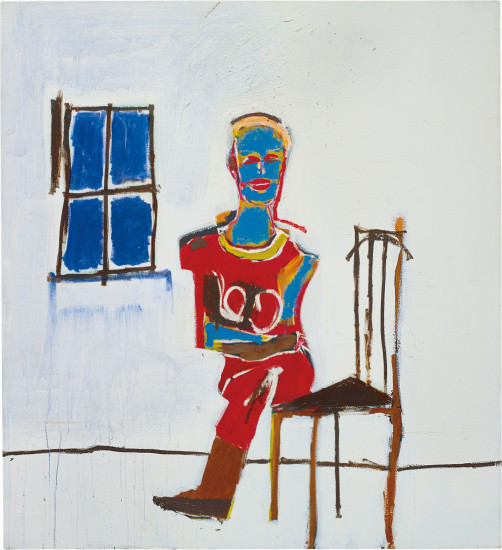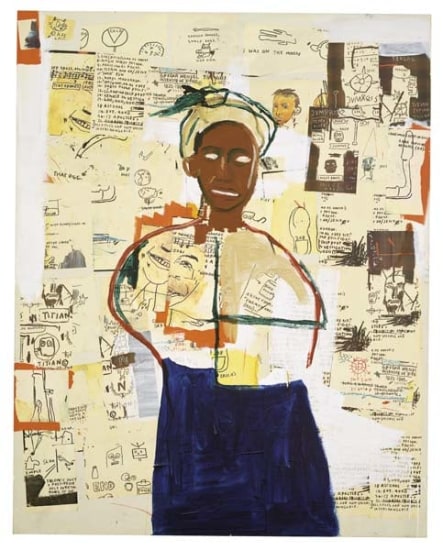◆ 19 Jean-Michel-Basquiat Follow Bird as Buddha signed, titled, inscribed and dated '"BIRD AS BUDDHA BHUDDA"' Jean-Michel-Basquiat 1984' on the reverse acrylic and oilstick on canvas 160 x 152.4 cm (62 7/8 x 60 in.) Executed in 1984.
Provenance Galerie Bruno Bischofberger, Zurich Mary Boone Gallery, New York Private Collection, Spain Private Collection, Switzerland Sotheby's, New York, 18 May 2000, lot 190 Private Collection Christie's New York, 12 May 2004, lot 391 Private Collection Koller Auktionen AG, Zurich, 24 June 2005, lot 3091 Acquired at the above sale by the present owner Exhibited New York, Mary Boone Gallery, Jean-Michel-Basquiat , 5 - 26 May 1984, no. 6 (illustrated) Hong Kong, Gagosian Gallery, Jean-Michel-Basquiat , 21 May - 10 August 2013 Literature Kate Linker, 'Jean-Michel Basquiat Mary Boone Gallery', Artforum , 1984, pp. 90-91 (illustrated) Richard Marshall, Jean-Louis Prat, Jean-Michel-Basquiat , vol II, Paris, 1996, no. 4, pp. 132-133 (illustrated, p. 132) Richard Marshall, Jean-Louis Prat, Jean-Michel-Basquiat , vol II, Paris, 2000, no. 4, pp. 216-217 (illustrated, p. 216) Catalogue Essay Executed in 1984, the present work stems from the height of Jean-Michel-Basquiat’s explosive and prolific career, having honed and consolidated his, now iconic, stylistic and symbolic imagery. Creating a shared visual language that appears across the various works from Basquiat’s output, the artist’s leitmotifs create a unanimous wealth of imagery that are spontaneously reinterpreted and reworked throughout his oeuvre. One chosen subject, the legendary jazz musician Charlie Parker, surfaced several times, eponymously addressed by Basquiat as ‘Bird’, Parker’s infamous nickname. Bird as Buddha , a powerfully personal work, signifies the artist’s connection to the jazz virtuoso and presents a poetic reflection on the symbiosis of soul and fearlessness. Several parallels can be drawn between Charlie Parker and Jean-Michel-Basquiat. Leading a distinguished but short-lived career that was prematurely cut-short as a result of his untimely death, Parker was one of the most prevalent names in his field at the time Basquiat was working, and had a profound influence on the artist’s work. Addressing the theme in prominent works such as Bird on Money, 1981, and Horn Players, 1983 (The Broad Collection, Los Angeles), Basquiat’s concern with the subject celebrated in the present work lies at the forefront of his oeuvre. Not only was the jazz doyen depicted in the works themselves, it was rumoured that Basquiat would also listen to his music in his studio, a poignant accompaniment to the present work. Most importantly though, both Parker and Basquiat can both be seen to elevate and intellectualise their respective art forms. Parker was working to overturn the lingering racism and cynicism surrounding jazz as a lesser form of music, while Basquiat challenged the prevailingly white art establishment as a mixed race and multicultural young artist. In Bird as Buddha the artist knowingly aligns himself with an art-historical tradition that he rarely confronted: formalised portraiture, as opposed to the artist’s more frequent études or studies of figures. This is further substantiated by Basquiat’s ironic title, referring humorously to a history of painters’ tendencies to paint their subjects ‘as’ something else. Parker himself is totally unrecognisable without Basquiat’s titular accompaniment, scrawled on the back of the canvas. His face itself, distorted beyond recognition, supposedly depicts the mergence of Parker with Siddhārtha Gautama, known later as the founder of Buddhism. Almost comic in its representation, with its lurid grimace purporting to be a wide, beaming grin that arguably embodies Parker’s buoyant, extroverted personality and lifestyle, the portrait is both vivid and expressive in fusing the two visages. In combining the Buddha, his religious principles of ‘samsara’ (the transferral of energy after death), with Parker, whose tragic death at a young age shook the jazz community, Basquiat explores the cyclical nature of art; he positions himself as an inheritor of artistic energy – the next to carry the baton - within the tradition of genre-defining arti
◆ 19 Jean-Michel-Basquiat Follow Bird as Buddha signed, titled, inscribed and dated '"BIRD AS BUDDHA BHUDDA"' Jean-Michel-Basquiat 1984' on the reverse acrylic and oilstick on canvas 160 x 152.4 cm (62 7/8 x 60 in.) Executed in 1984.
Provenance Galerie Bruno Bischofberger, Zurich Mary Boone Gallery, New York Private Collection, Spain Private Collection, Switzerland Sotheby's, New York, 18 May 2000, lot 190 Private Collection Christie's New York, 12 May 2004, lot 391 Private Collection Koller Auktionen AG, Zurich, 24 June 2005, lot 3091 Acquired at the above sale by the present owner Exhibited New York, Mary Boone Gallery, Jean-Michel-Basquiat , 5 - 26 May 1984, no. 6 (illustrated) Hong Kong, Gagosian Gallery, Jean-Michel-Basquiat , 21 May - 10 August 2013 Literature Kate Linker, 'Jean-Michel Basquiat Mary Boone Gallery', Artforum , 1984, pp. 90-91 (illustrated) Richard Marshall, Jean-Louis Prat, Jean-Michel-Basquiat , vol II, Paris, 1996, no. 4, pp. 132-133 (illustrated, p. 132) Richard Marshall, Jean-Louis Prat, Jean-Michel-Basquiat , vol II, Paris, 2000, no. 4, pp. 216-217 (illustrated, p. 216) Catalogue Essay Executed in 1984, the present work stems from the height of Jean-Michel-Basquiat’s explosive and prolific career, having honed and consolidated his, now iconic, stylistic and symbolic imagery. Creating a shared visual language that appears across the various works from Basquiat’s output, the artist’s leitmotifs create a unanimous wealth of imagery that are spontaneously reinterpreted and reworked throughout his oeuvre. One chosen subject, the legendary jazz musician Charlie Parker, surfaced several times, eponymously addressed by Basquiat as ‘Bird’, Parker’s infamous nickname. Bird as Buddha , a powerfully personal work, signifies the artist’s connection to the jazz virtuoso and presents a poetic reflection on the symbiosis of soul and fearlessness. Several parallels can be drawn between Charlie Parker and Jean-Michel-Basquiat. Leading a distinguished but short-lived career that was prematurely cut-short as a result of his untimely death, Parker was one of the most prevalent names in his field at the time Basquiat was working, and had a profound influence on the artist’s work. Addressing the theme in prominent works such as Bird on Money, 1981, and Horn Players, 1983 (The Broad Collection, Los Angeles), Basquiat’s concern with the subject celebrated in the present work lies at the forefront of his oeuvre. Not only was the jazz doyen depicted in the works themselves, it was rumoured that Basquiat would also listen to his music in his studio, a poignant accompaniment to the present work. Most importantly though, both Parker and Basquiat can both be seen to elevate and intellectualise their respective art forms. Parker was working to overturn the lingering racism and cynicism surrounding jazz as a lesser form of music, while Basquiat challenged the prevailingly white art establishment as a mixed race and multicultural young artist. In Bird as Buddha the artist knowingly aligns himself with an art-historical tradition that he rarely confronted: formalised portraiture, as opposed to the artist’s more frequent études or studies of figures. This is further substantiated by Basquiat’s ironic title, referring humorously to a history of painters’ tendencies to paint their subjects ‘as’ something else. Parker himself is totally unrecognisable without Basquiat’s titular accompaniment, scrawled on the back of the canvas. His face itself, distorted beyond recognition, supposedly depicts the mergence of Parker with Siddhārtha Gautama, known later as the founder of Buddhism. Almost comic in its representation, with its lurid grimace purporting to be a wide, beaming grin that arguably embodies Parker’s buoyant, extroverted personality and lifestyle, the portrait is both vivid and expressive in fusing the two visages. In combining the Buddha, his religious principles of ‘samsara’ (the transferral of energy after death), with Parker, whose tragic death at a young age shook the jazz community, Basquiat explores the cyclical nature of art; he positions himself as an inheritor of artistic energy – the next to carry the baton - within the tradition of genre-defining arti

.jpg)









Try LotSearch and its premium features for 7 days - without any costs!
Be notified automatically about new items in upcoming auctions.
Create an alert